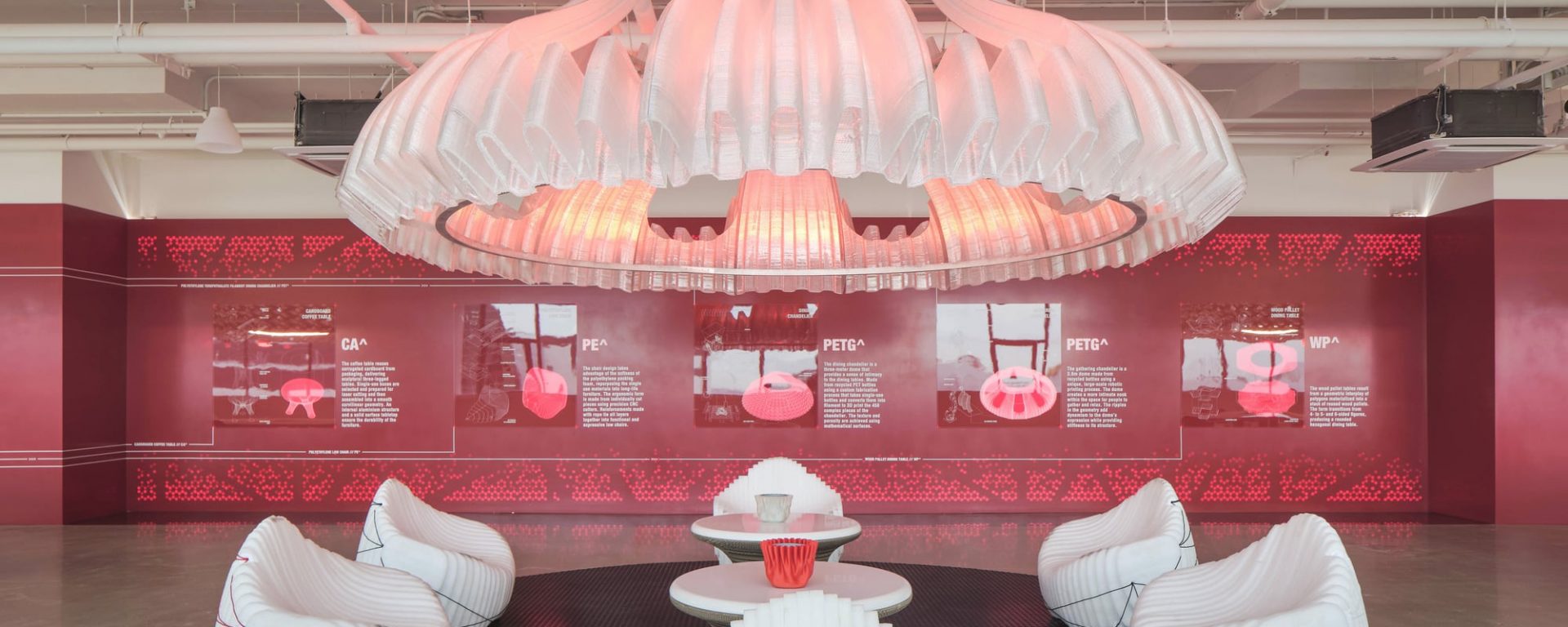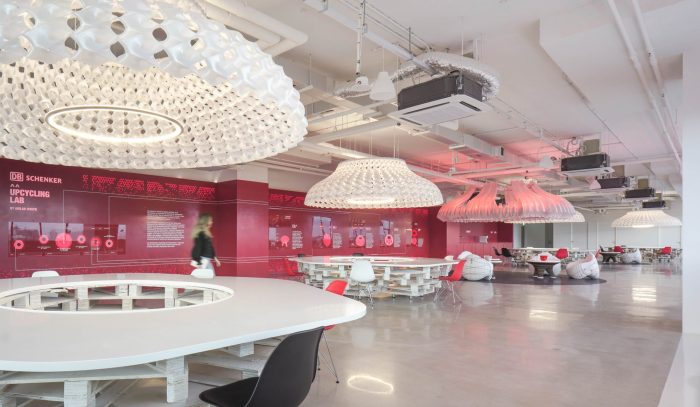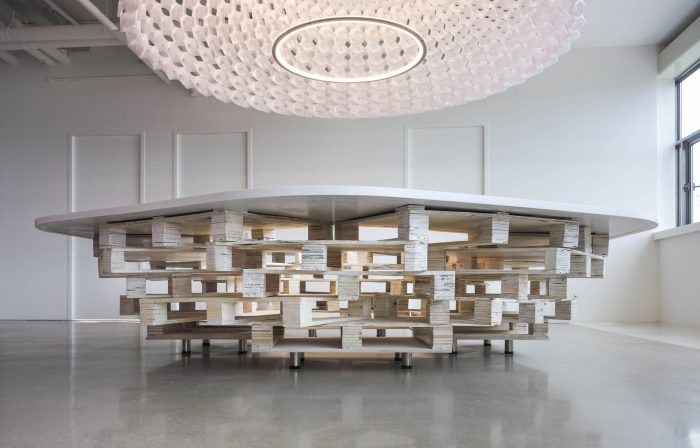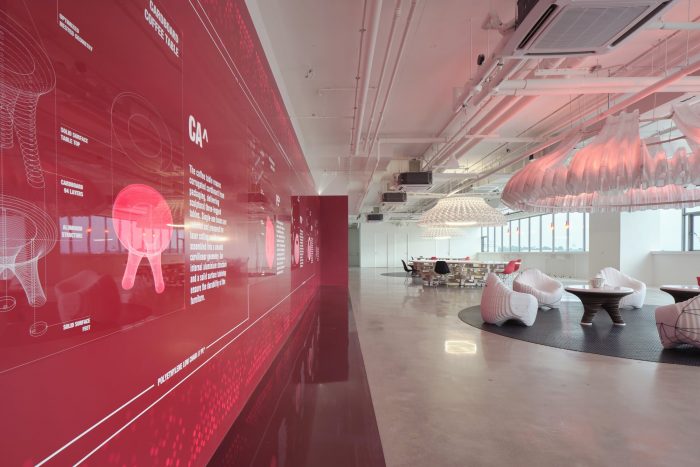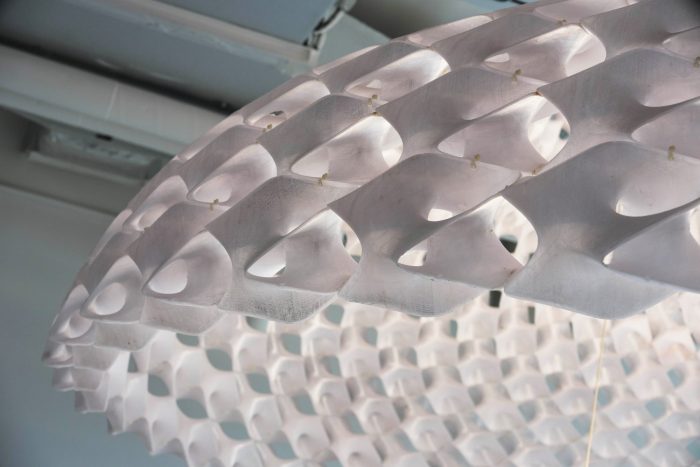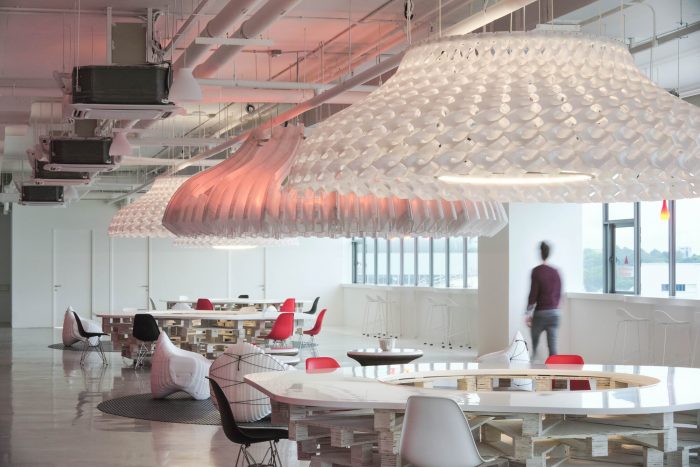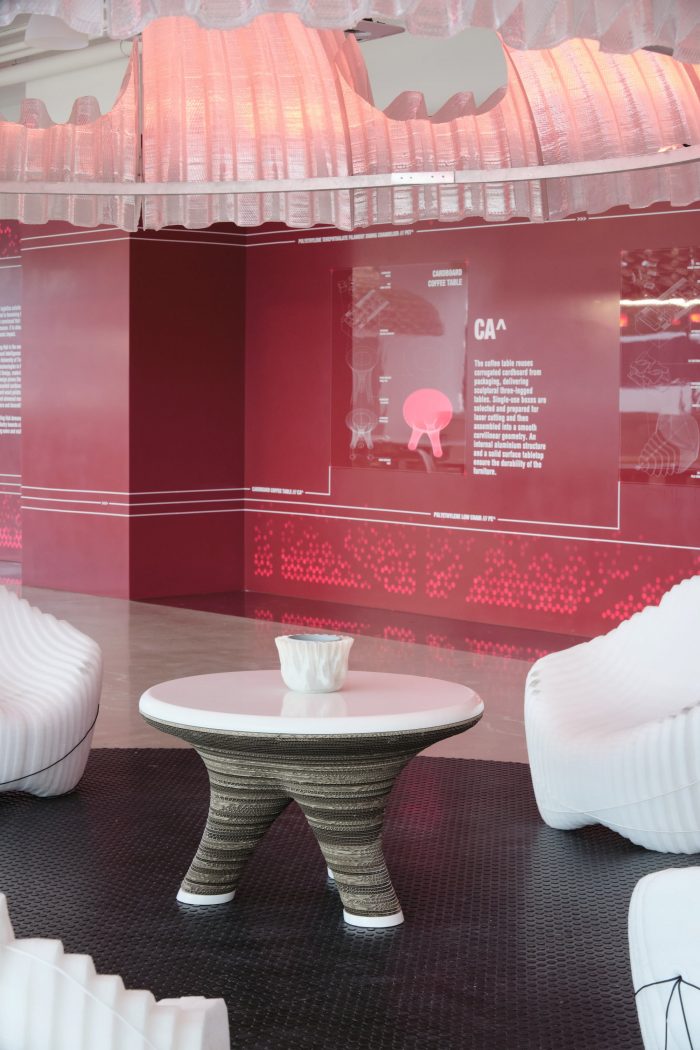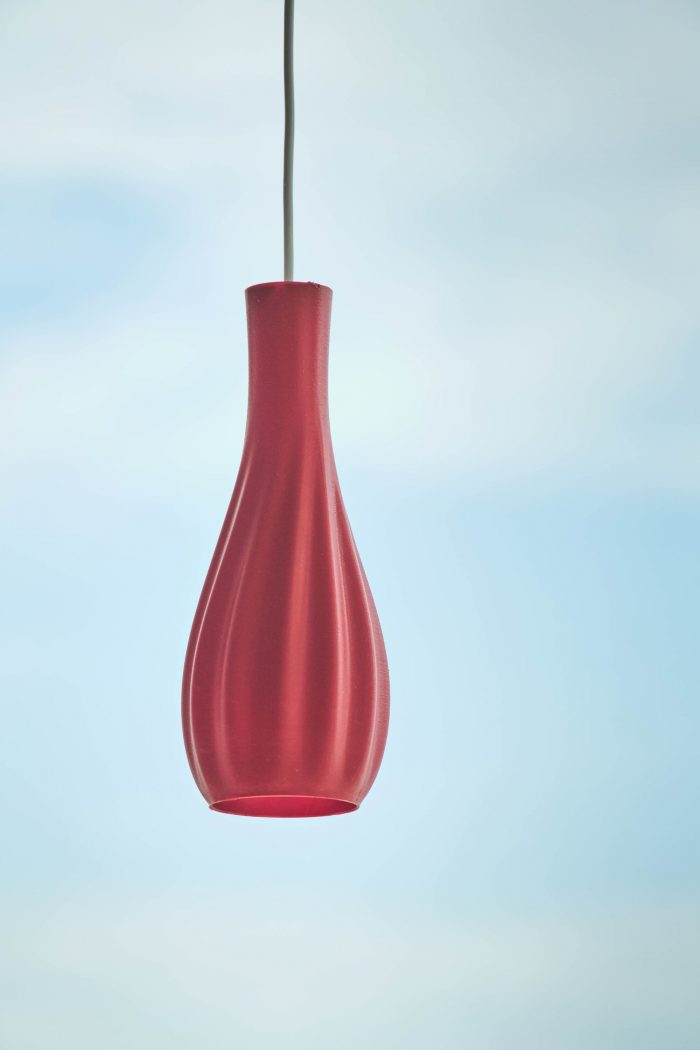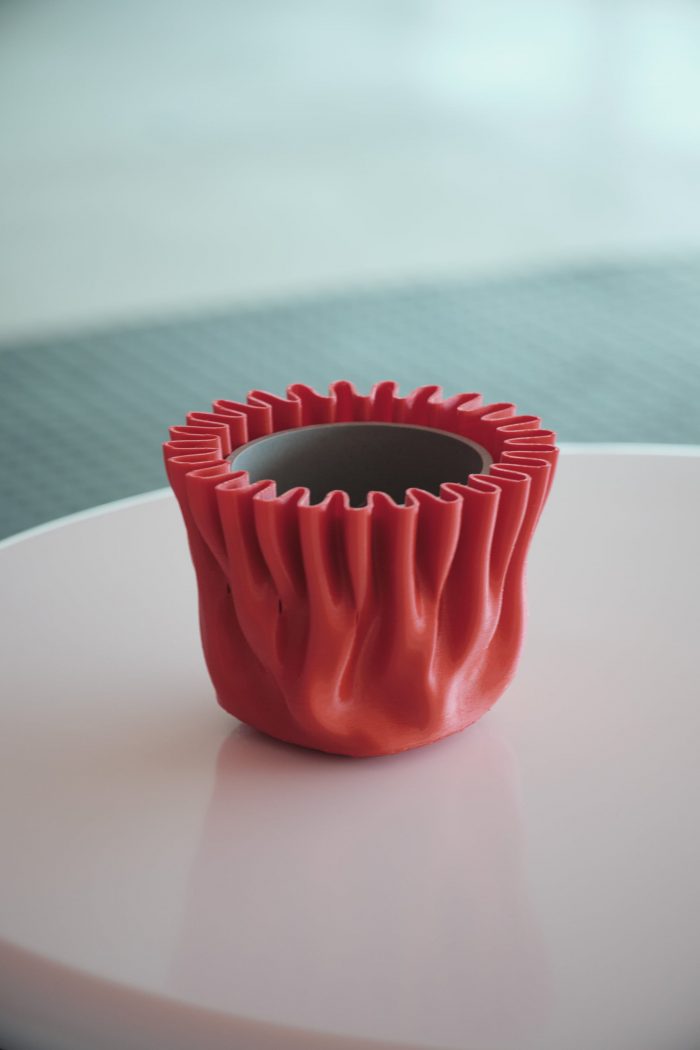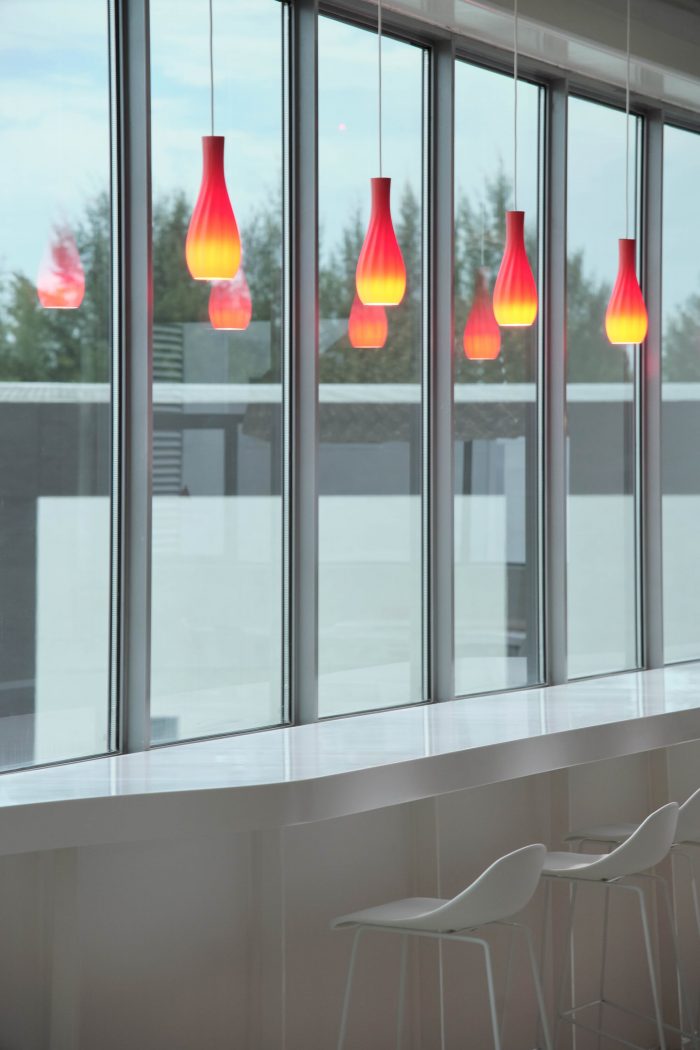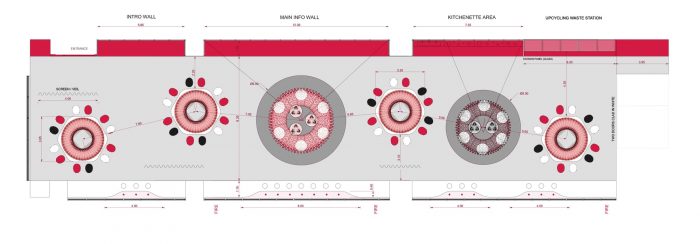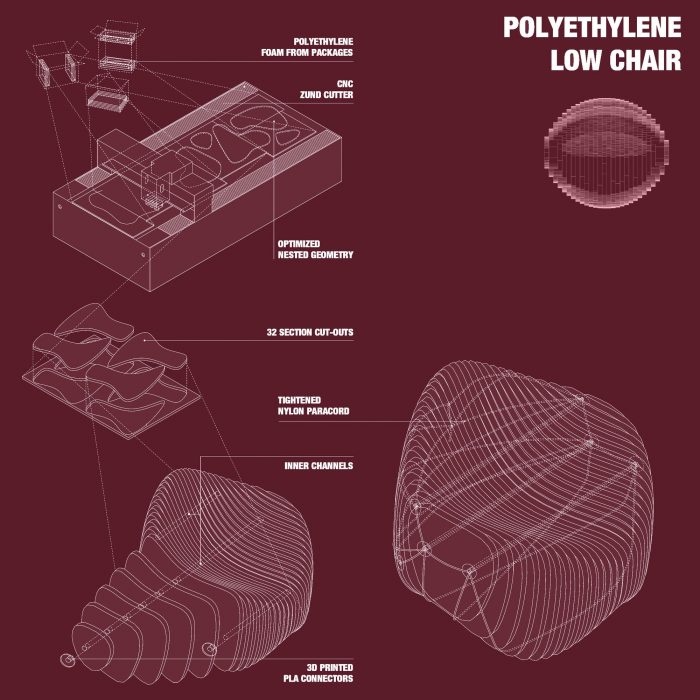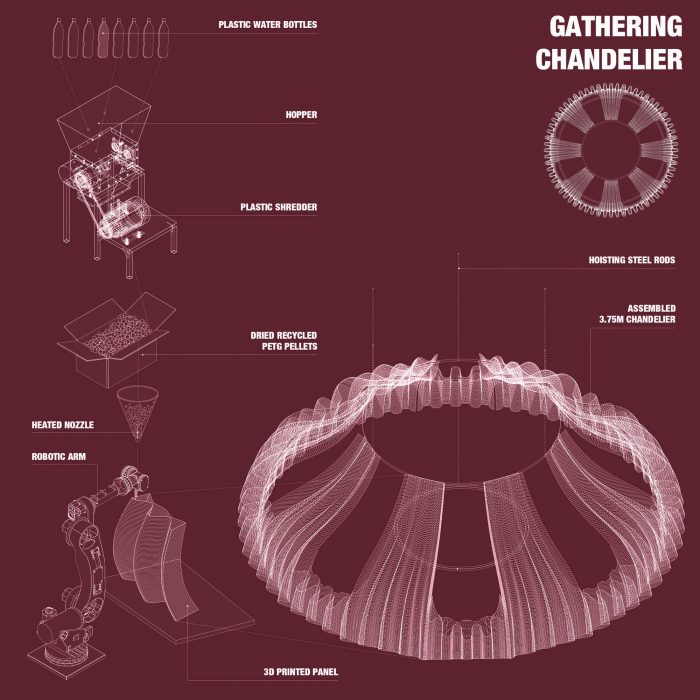随着可持续发展成为建筑和设计行业中一个更加普遍和必要的话题,需要探索新的生产方式。由Airlab SUTD设计的位于新加坡的德铁信可升级改造中心展示了未来的制造业,提出了通过回收废弃材料来应对气候危机的新方法。该项目设置了一个平台,挑战我们的价值体系和对废弃材料的传统理解,通过数字设计和可持续的制造方法,用废弃的塑料和木材创造美丽的家具,重新定义我们与废物的关系。
As sustainability becomes a more prevalent and necessary topic in the architecture and design industry, new means of production need to be explored. The DB Schenker’s Upcycling Hub in Singapore, designed by Airlab SUTD, demonstrates the future of manufacturing by presenting novel ways to respond to the climate crisis by recycling waste material. The project sets a platform to challenge our value systems and traditional understanding of waste material, redefining our relationship with waste by creating beautiful furniture with discarded plastic and wood through digital design and sustainable manufacturing methods.
该项目始于2018年,雄心勃勃地想通过从废料中开发一个空间,在用户和游客中建立对物流和供应行业的循环性的认识。最初是以德铁信可员工午餐室的设计方案为起点,AirLab的目标从最初的方案范围发展到了 “大房间”。升级改造中心的设计是为了展示废弃材料的价值。这创造了一个空间,通过新的3D打印工艺,重新评估我们对废物在所有供应链阶段的理解,包括设计、生产和消费。
The project started in 2018 with the ambition to create awareness of the circularity in the logistics and supply industry among users and visitors by developing a space from waste material. Initially starting with a brief for the DB Schenker employee lunchroom, AirLab’s goal evolved from the initial brief’s scope to become the “large room.” The Upcycling Hub was designed to showcase the value of waste material. This creates a space to reassess our understanding of waste throughout all supply chain stages from design, production, and consumption through new 3D printing processes.
这个新的公共空间利用了增材制造和数字设计方面的新技术,将从废物中提取的材料升级改造为功能和优雅的设计作品。使用超过3万个塑料瓶,废弃的纸板箱、泡沫包装和木质托盘通过3D打印和计算机数控切割被赋予了第二次生命,生产出美丽的家具和空间。
This new communal space leverages new technologies in Additive Manufacturing and Digital Design, with materials derived from waste upcycled into design pieces that are functional and elegant. Using more than 30,000 plastic bottles, discarded cardboard boxes, foam packages, and wood pallets are given a second life through 3D printing and computer numerical control cutting, producing beautiful furniture and spaces.
空间的务实布局分为三条带子:红色的墙面,所有的设计都用技术轴测图来解释,解决了制造过程中的深度和复杂性;窗边的白色带子通过创造一个长桌,将开放的视野和自然光最大化,精致的吊灯由生物聚合物3D打印而成;中央区域,社会活动在回收的PETG吊灯下发展;周围则是包容的托盘桌、纸板咖啡桌和泡沫椅。这是新加坡第一个采用尖端技术和数字设计流程的室内设计,将废物重新用于功能性和优雅的室内空间,为用废物构思装饰品、家具和空间的全新方式铺平道路。
The pragmatic layout of the space is organized in three bands: the red wall, where all designs are explained using technical axonometric drawings, addressing the depth and complexity of the processes used during fabrication; the white band at the window side maximizes open views and natural light by the creation of a long table, where delicate pendant lights are 3D printed from biopolymers; the central area, where social activity is developed under the recycled PETG chandeliers; and around inclusive pallet tables, cardboard coffee tables, and foam chairs. It is the first Interior Design in Singapore to implement cutting-edge technologies and digital design processes to repurpose waste into functional and elegant interior spaces paving the path for an entirely new way of conceiving ornament, furniture, and spaces from waste.
PET吊灯的功能是在一个空间内创造空间,并将员工午休和聚会的充足的休息空间分解成更多的封闭和亲密的空间。两种不同类型的吊灯被开发出来,以推进对建筑中两种最不同的聚合物打印工艺的研究。使用FDM桌面打印机的大型组件和定制的FDM机器人系统。在这两种情况下,回收的PET被测试为主要原料,分别为长丝和颗粒形式。
The function of the PET chandeliers was to create spaces within a space and to break down the ample lounge space where employees have lunch breaks and gather into more contained, intimate spaces. Two different types of chandeliers were developed to advance research on the two most distinct polymer printing processes in architecture: Large assemblies of components using FDM desktop printers and a custom-built FDM robotic system. In both cases, recycled PET was tested as the main feed, in filament and pellet form, respectively.
聚会吊灯是一个直径为4米的圆顶状照明装置,由16个大型机器人打印件组成。它的设计是通过参数化生产的,可以通过单一的、连续的挤压来制造。每个部件的边框尺寸约为1.50×0.60,0.40米。吊灯使用一个顶环悬挂在天花板上。在底部部分,一个压缩环包含了照明元件。制造过程是由研究小组开发和校准的。它包括一个大型的ABB机械臂和一个装有200公斤回收PET颗粒的挤出机。
The Gathering Chandelier is a 4m diameter dome-like lighting fixture made of 16 large, robotically printed pieces. Its design was parametrically produced to be manufacturable with single, continuous extrusion. Each component’s bounding box size is around 1.50×0.60, 0.40m. The chandelier was suspended from the ceiling using a top ring. On the bottom part, a compression ring contains the lighting elements. The fabrication process was developed and calibrated by the research team. It consists of a large ABB robotic arm and an extruder fed with 200 kg of recycled PET pellets.
此外,四个餐饮吊灯测试了使用传统的FDM 3D打印机和回收的PET长丝创建一个大型的建筑装置。为这个项目创建了四个相同的3.5米直径的吊灯。穹顶由10排每排45个部件组成,每个穹顶有450个部件。这450个部件中的每一个都被设计成可以用标准的FDM打印机打印,建造体积小于200x200x100mm。每块瓷砖的几何形状是基于最小的Schwarz D(”钻石”)表面,它被设计为可打印的,没有支撑物,在其制造过程中产生零浪费。穹顶中最上层的元素被明确地设计为与一个铝环相连接,将穹顶悬挂在天花板上。照明是用一个悬挂在中心的LED环来解决的,并向吊灯投射光线。对组件之间的连接给予了仔细的关注,用隐藏尼龙螺母和螺栓的功能来解决这个问题。四个穹顶中的每一个所回收的塑料总量为60公斤。
In addition, the four Dining Chandeliers test the creation of a large-scale architectural fixture using conventional FDM 3D printers and recycled PET filament. Four identical 3.5m diameter chandeliers were created for this project. The domes consist of 10 rows of 45 pieces each, accounting for 450 pieces per dome. Each of the 450 components was designed to be printable with a standard FDM printer, with built volumes smaller than 200x200x100mm. The geometry of each tile was based on a minimal Schwarz D (“Diamond”) surface, and it was designed to be printable without supports, producing zero waste in its fabrication. The uppermost element in the dome was explicitly designed to interface with an aluminum ring that suspends the dome from the ceiling. The lighting was solved with an LED ring suspended in the center and projecting light toward the chandelier. Careful attention was given to the connection between components, which was solved with features that concealed nylon nuts and bolts. The total plastic recovered for each of the four domes is 60kg.
空间的用户也通过实施和表达他们的意见积极参与到设计和组装过程中,特别是他们希望看到的废物与家具的区别。这种参与提供了关于3D打印制造如何执行的重要信息,并将权力放在用户手中,以学习这些新技术。这表现在员工参与到概念化、废物采购和组装中,这创造了一种对他们共同创造的空间的所有权,发展了对所用材料的新的欣赏。
Users of the space were also actively involved in the design and assembly process by implementing and expressing their views, especially what waste versus what furniture they wished to see. This engagement provided vital information on how 3D printing fabrication could perform and put power in the hands of users to learn these new techniques. This manifested in employees getting involved in conceptualization, waste sourcing, and assembly, which created a sense of ownership of their co-created space, developing a new appreciation for the materials used.
这个项目展示了被认为是无用的、注定要被填埋的材料是如何被重新利用为实用和美丽的设计品的。此外,升级再造中心是一个教育工具,可以激励用户、设计师和年轻一代进行实验。在现代社会中,废物已经困扰了几十年,而且往往被忽视,而不是正面解决,德铁信可升级改造中心挑战这种教条,打算为其业务中产生的废物找到新的生命力。成功地执行这一点使他们的用户感到有能力找到未来的解决方案,以解决我们今天的技术每天面临的废物危机。
This project demonstrates how materials deemed useless and destined for landfills can be repurposed into functional and beautiful design objects. Furthermore, the Upcycling Hub is an educational tool to inspire users, designers, and younger generations in experimentation. Where waste has plagued decades of modern societies and is often ignored rather than addressed head-on, the DB Schenker Upcycling Hub challenges this dogma by intending to find a new lease of life for the waste produced in their business. Successfully executing this enabled their users to feel empowered to find future solutions to the waste crisis we face daily with today’s technologies.
客户对向他们的国际分支机构展示这个新的空间深感自豪,因为它是可持续发展的象征,也是对致力于未来循环经济的可能性的明确证明。有了他们的参与,Upcycle Hub已经成为第一个展示从设计到执行的整个5000平方米的升级改造项目的空间。它标志着技术和公司的承诺如何使可持续性成为可能。此外,使用废旧材料使用户对空间的集体拥有感恢复了活力。有了这种新的意识,他们现在可以更好地理解、欣赏和参与建设可持续的空间。
The client is deeply proud to showcase this new space to their international branches as an emblem of sustainability and a clear testament to the possibilities when one commits to the future circular economy. With their participation, The Upcycle Hub has become the first space to showcase a full 5,000 sqft of an upcycled project from design to execution. It signals how technology and a company’s commitment can make sustainability possible. Furthermore, using waste material has rejuvenated users’ collective sense of ownership of space. With this new sense of awareness, they can now better understand, appreciate, and participate in constructing sustainable spaces
Architects: AIRLAB
Year : 2022
Photographs :Fabian Ong
Project Lead : Carlos Bañón
Project Team : Carlos Bañón, Félix Raspall, Sourabh Maheshwary, Wan Mengcheng, Simon Rocknathan, Tay Boon Kiat, Kwang Kai Jie, Megan Chor Xin Yi, Tai YiJie, Alba Lombardía Alonso, Nahaad Vahid, and Cosmo Wezembeek.
Country : Singapore

